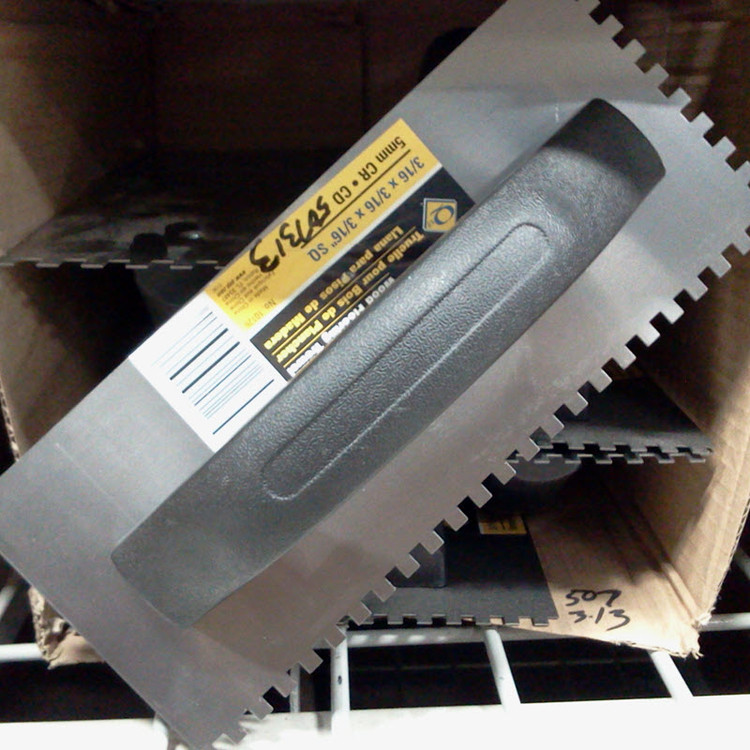9 Top Questions About Trowels
Posted by TOA's Blog Team on Feb 8th 2024
Do you have questions about trowels? We've come up with nine that frequently come up since - along with other tile installation products and tools (see How to Cut Glass Tile and Wood Plank Tile: Cortag Demonstration) - you can find trowels when you visit Tile Outlets of America.
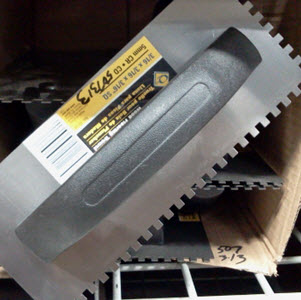
Answers to Your 9 Top Questions About Trowels
1. What do you use trowels for?
Trowels are typically used for mixing, scooping, skimming, and spreading during the installation of tile.
Trowels can also be used to install numerous types of backer board, membrane, masonry block, and glass.
The proper trowel is essential to the success and longevity of the installation.
2. What are the different types of trowels available?
Trowels come in different shapes and sizes depending on the size of the tile you're installing. In addition to specialty trowels such as a margin trowel, a flat trowel and a bucket trowel, the three shapes that are important for you to know about are the V-notch, the U-notch and the Square notch trowels. The notch shapes affect how much thin set you can spread.
Each trowel shape is available in a range of sizes.
Let's discuss each shape.
V-Notch Trowels
A V-notch trowel - as the name suggests - has V-shaped edges to it. If you are installing mosaic tile, this is typically the trowel to use as it will leave the least amount of thin set on your installation substrate.
A typical size to use for mosaics and up to 4 ½” glazed wall tile is a 3/16” x ¼” V-notch trowel.
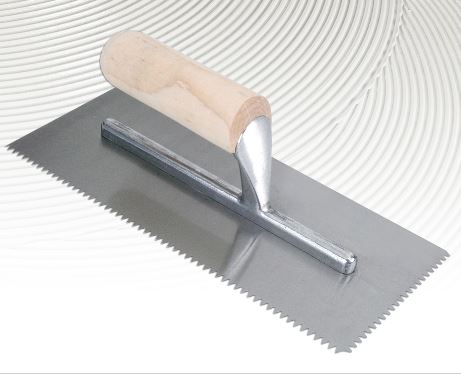
A typical size to use for mosaics and up to 4 ½” glazed wall tile is a 3/16” x 1/4” V-notch trowel.
U-Notch Trowels
As you can see in the image below, the biggest difference between the V- and the U-shape trowels has to do with the notches or teeth. A U-notch trowel spreads more thin set than a V-shaped trowel. For that reason, this is a shape to use for tiles larger than 4".
Two commonly used sizes are:
- U- Notch Trowel ¼” x ¼" - used for 4”x4” up to 8”x8” tile. This is the preferred trowel for those who want a heavy spread for wall tile OR a lighter spread for floor tile.
- U- Notch Trowel ¼” x 3/8” – can be used for 8”x8” up to 16”x16”. This, too, is the preferred trowel for those who want a heavy spread for wall tile OR a lighter spread for floor tile.
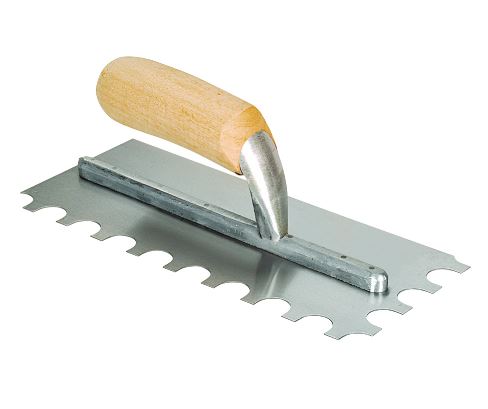
A U-notch trowel spreads more thin set than a V-shaped trowel.
For that reason, it is used for tiles larger than 4".
Square Notch Trowels
Similarly, the Square notch trowel - unlike the V-notch and the U-notch - has square teeth. As with the U-notch, you use the Square notch for any tile over 4".
What's different is that the Square notch trowel spreads more thin set than the U-notch does.
Three commonly used trowel sizes are:
- Square Notch Trowel ¼”x ¼” for tile 4” x 4” up to 8”x 8”
- Square Notch Trowel 1/4” x 3/8” for tile 8”x8” up to 13”x13”
- Square Notch Trowel 1/2”x 1/2” for 16”x16” and larger tile
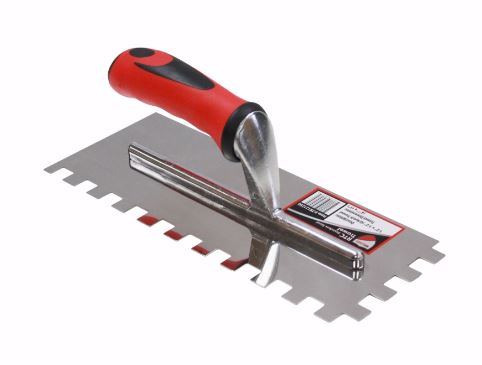
Use the Square notch for any tile over 4"
Specialty Trowel - Margin Trowels
A few more trowels you may find helpful...
The Margin Trowel is used to mix thin set, scoop, and spread materials into tight spaces as you can see in the image below. You can find margin trowels with teeth.
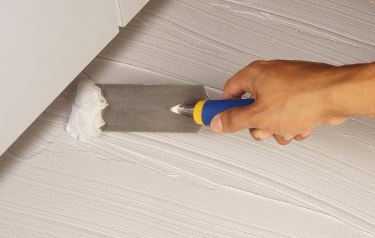
The Margin Trowel is used to mix thin set, scoop, and spread materials into tight spaces.
Specialty Trowel - Flat Trowels
A Flat Trowel is also known as a finishing trowel and used to smooth a surface area. It has no teeth.
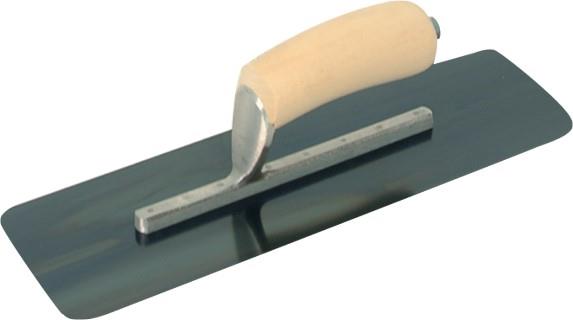
A Flat Trowel is also known as a finishing trowel and used to smooth a surface area.
Specialty Trowel - Bucket Trowels
A Bucket Trowel is used for removing plaster or mortar without damaging the bucket. As you can see, it has no teeth.
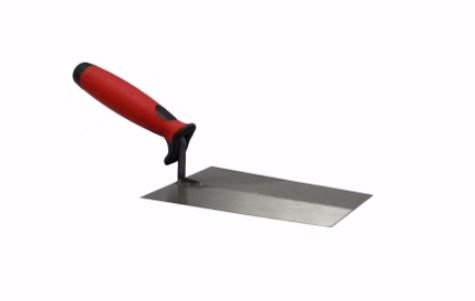
A Bucket Trowel is used for removing plaster or mortar without damaging the bucket.
3. What do trowel measurements mean?
As we mentioned, the different trowel shapes come in different sizes. The sizes, though, aren't simply a matter of small, medium or large.
Generally, the trowel size you select will match up to the tile size you're working with. If it's small tile, you'll pick a smaller trowel. If you're installing large format tile, you'll want a larger trowel.
However, beyond that point, you'll need to get more specific based on measurements.
Trowels are measured by the length and height or depth of the notches or teeth. A ¼” x ¼” trowel, then, will have a notch that is ¼” square. (See diagram below from What Size Trowel to Use for Tile.)

Trowels are measured by the length and height or depth of the notches or teeth.
4. How do you choose the right size trowel for your tile installation project?
The specific trowel size will depend on the tile size, the thickness and the surface type (e.g., floor or wall) of the installation with the goal of achieving proper coverage with the thin set.
5. What is proper thin set coverage?
As Using the proper trowel explains,
The first thing you need to know is what constitutes proper coverage. As stated in ANSI A108.5 3.3.2 for installation of tile on floors; “Average uniform contact area shall not be less than 80% except on exterior or shower installations where contact area shall be 95% when no less than three tiles or tile assemblies are removed for inspection. The 80% or 95% coverage shall be sufficiently distributed to give full support to the tile with particular attention to this support under all corners of the tile.”
Let me translate that for you:
Proper coverage of any tile in a dry area (bathroom floors, backsplashes, fireplaces, etc.) is 80%. Proper coverage of any tile in a wet area (showers) or outdoors is 95%. This includes complete coverage beneath all corners of the tile. You check this by installing a tile, then removing it to check the CONTACT of the thinset on the back of the tile. If, after checking three different tiles in three different areas of the installation, you have that percentage of coverage then you have proper coverage.
In other words, you may need to experiment with a trowel size and then check whether you have proper coverage. If not, you may need a larger trowel.
>> See the Trowel Guide on JohnBridge.com Forum (scroll down a bit for the chart).
6. What's the best way to properly use a trowel?
It is always important to key in the mortar with the flat side of the trowel for a good chemical bond.
Then, add more mortar to the substrate spreading the mortar in straight lines all going in one direction. This will provide better distribution of the mortar.
- Be sure not to “swirl” the mortar. This will create voids that will not allow the tile to properly bond to the substrate. Under normal use this can result in cracked tile.
- Additional “buttering” of the tile may be needed due to the tile, wall, or floor conditions.
>> See How To Install Tile Correctly and Get Proper Mortar Coverage
7. How many trowels do you need for a tile installation project?
The number of trowels for each job can vary. It depends on how many different size(s) of tile you are installing and how much preparation is needed.
8. How do you clean a trowel?
It's best to clean a trowel with a hose sprayer, and or a clean sponge and water immediately after use.
If mortar or adhesive hardens on the trowel, an electric grinder may be necessary to remove the hardened material from the trowel.
9. When do you need to replace a trowel?
When the square notches or edges of the trowel become bent and/or worn, that's when it's best to replace the trowel.
It's also important to clean the tools properly. If you don't properly maintain your trowels - or if you use a worn trowel - it may jerk or skid on the slab which could mean that you've improperly applied the material.
Do You Have Any Other Questions About Trowels?
If yes, please let us know and we'll add to this list.
You'll find over 20 trowels to choose from (with various notch sizes) when you shop Tile Outlets of America. If you have any questions about the right size trowel to buy for your project, don't hesitate to ask one of our sales associates
Special thanks to Gary Tuhro for sharing his expertise in this article.
>> Shop Trowels <<


